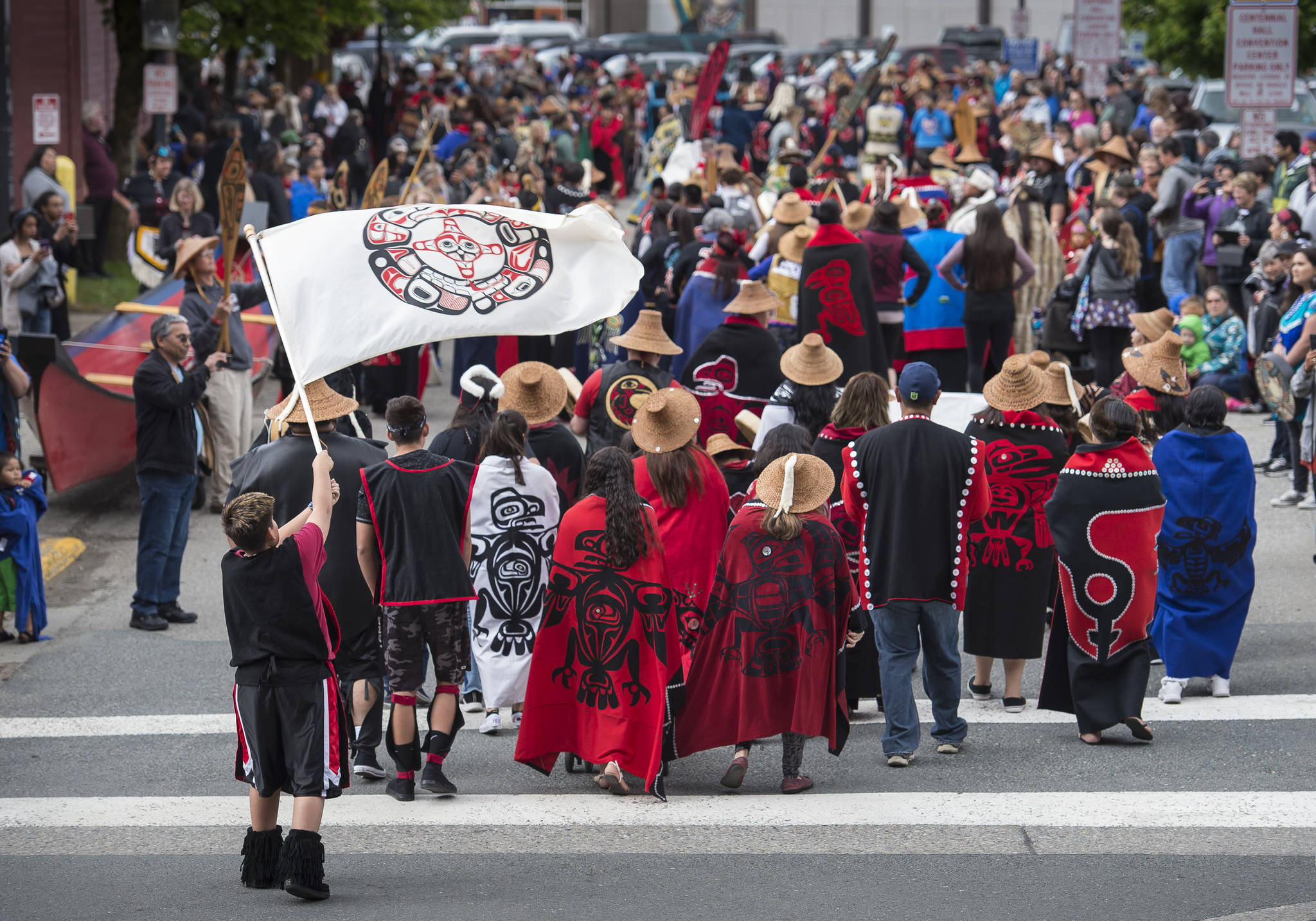It’s over, but Celebration will be back in 2020.
Juneau’s biggest honoring of Native culture ended with a parade and multiple events Saturday. In the morning, drum beats and traditional song echoed as a parade of dance groups in traditional regalia marched through downtown.
The parade ended at Centennial Hall, where a photographer set up Celebration participants up for a group photo. Elders sat in chairs with children at their feet. A group of Native servicemen and veterans took a knee next to them. Friends, family and the middle aged took their place in the back.
With a blast of a megaphone, a photographer told the group to “think of smoked Hooligan — that’ll make you smile.”
Then, after the photo, he said, “Go dance.”
With that, another Celebration was memorialized.
This year’s event marked 36 years since the biennial Celebration started in 1982. Juneau man and Tlingit elder David Katzeek has attended Celebration since the start. He was in the middle of the panoramic photo, draped in a Chilkat blanket.
“It feels really, really good,” he said, to be gathered with friends and family, celebrating their shared culture.
Celebration has grown a lot since it started, Katzeek said. Participation has gone way up, especially from dance groups.
The elders who taught Katzeek organized the original Celebration, he said. That was held in February of 1982, a month picked to include visiting state legislators to the event, Katzeek said. It’s since moved forward in the calendar year.
While the event has grown over the years and the date has changed, Katzeek said some of the issues Native communities deal with have stayed the same. The Native community has always been a persevering one, he said. Celebration is a way to uplift one another and to demonstrate a fighting spirit.
“We’re still dancing, we’re still singing our songs,” Katzeek said.
One of those issues is the revitalization of Native languages. Native language use has come a long way since Celebration started, said Theo Bayou, a Tsimshian woman from Anchorage.
In the elders room at Centennial Hall, Bayou said she wasn’t allowed to speak her traditional language, Sm’álgyax, growing up. Her mother and grandmother were fluent, and she could speak Sm’álgyax when she was younger, but has since lost the ability. Now Bayou, who has been coming to Celebration since the early 1990s, takes Sm’álgyax classes taught by her daughter. Her grandchildren take the classes with her.
The younger generation is leading the revitalization of the language. That heartens Bayou.
“It really makes a difference, when you have someone that wants to take the reigns of the wagon and lead everyone on. Younger people are doing that. It’s really good to see that,” Bayou said.
Dennis Katzeek, David’s brother, said Celebration helps chart a course for the future of Tlingit, Haida and Tsimshian culture. “It awakens and stays steadfast the course that our elders have set,” Dennis said.
The singing and dancing may be over, Dennis Katzeek said, but there’s always a song somewhere if you listen. Even the trees are singing, he said.
“Each one has their own leaf structure, shape in every way. They’ll dance, they’ll have their own song because of the wind that blows through, and they sing their song for each other. There’s no tree that can sing like they do. … That’s the way our people are too, we are like that,” Dennis said.
• Contact reporter Kevin Gullufsen at 523-2228 and kgullufsen@juneauempire.com. Follow him on Twitter at @KevinGullufsen.

